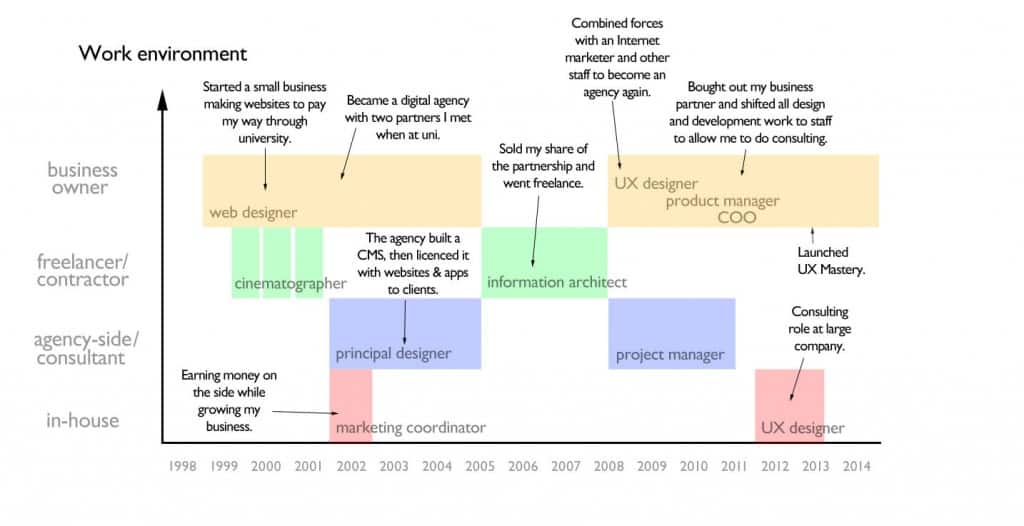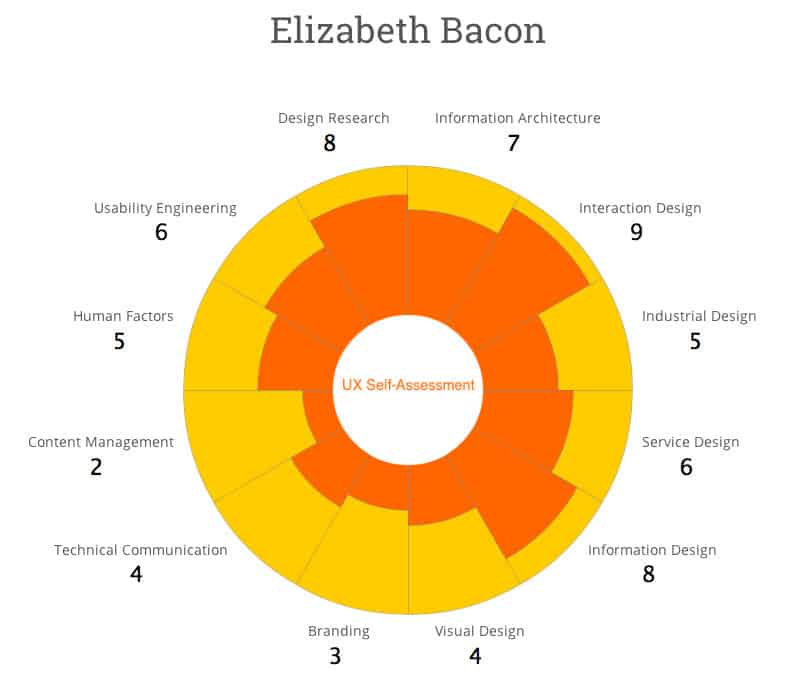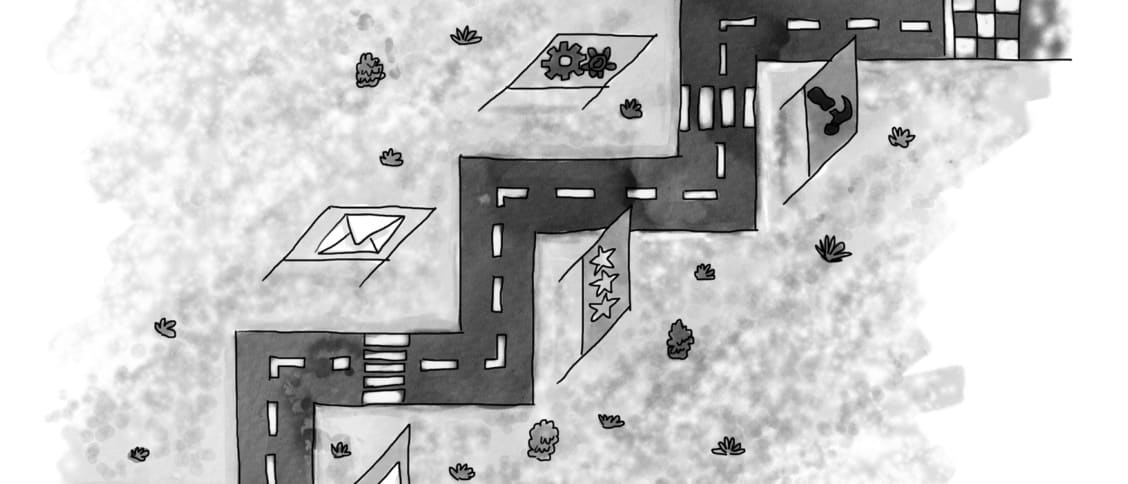As an intermediate or senior UX designer, how do you gain and maintain momentum in your career? In this guide, we’ll explain the value of creating a UX career roadmap—and show you how to do so.
UX design is a broad, multifaceted field that’s constantly evolving. The digital landscape is ever shifting, new technologies are emerging, and the principles of user experience design are constantly changing as a result. Today’s UX designers must stay up-to-date in order to act as mediators between humans and technology.
With so much opportunity to learn and grow, UX designers must ask themselves: What role do I want to play in this burgeoning industry?
No matter what stage you’re at in your career, it’s important to routinely consider the kind of designer you are now, and the kind of designer you want to become. Especially if you’ve been in the industry for a while, you might find yourself getting comfortable or losing sight of your aspirations.
This is where your UX career roadmap comes in: it’ll keep you focused on your goals, ensuring you’re constantly growing and developing as a designer.
In this guide, we’ll show you the value of creating a UX career roadmap. We’ll then lay out a step-by-step process you can follow to create your own roadmap from scratch. We’ll discuss:
- What is a UX career roadmap?
- Why create a UX career roadmap?
- How to create a UX career roadmap: A step-by-step guide
Let’s jump in.
1. What is a UX career roadmap?
A career roadmap sets out a clear plan of action for achieving your career goals. It considers the following questions:
- Where am I now?
- Where do I want to go?
- How will I get there?
Mapping out your UX career is not just about progressing from junior to senior—nor is it about aiming for a certain salary or job title. While these are important factors, an effective career roadmap should also dig a little deeper. It explores your strengths and weaknesses, identifies areas for professional development, and helps you forge a career that aligns with your personal goals and values.

A UX career roadmap depicts your aspirations, laying out the blueprint for your path as a UX designer. Whether it’s a simple flow diagram or a true work of art, there are many benefits of drawing up a UX career roadmap. Let’s take a look at the most important ones.
2. Why create one?
A career roadmap might seem like a lot of unnecessary work—especially if you’re not a fan of planning ahead. But, if you’re serious about your career as a UX designer, it’s worth the effort. Why? Because an effective UX career roadmap will:
- Help you achieve career satisfaction: In order to forge a fulfilling career, it’s important that your day-to-day work mirrors your personal values. You need to feel like you’re learning, growing, and contributing. A career roadmap keeps you on the right track; not only by making you aware of your goals, but also by ensuring you’re taking the necessary steps to achieve them.
- Hold you accountable: It’s easy to leave your career in the hands of fate, or to blame external factors if things don’t go as planned. A well-thought-out roadmap puts you in control of your career path, giving you the foresight to see what needs to be done in order to reach your desired destination.
- Make you a better UX designer: A career roadmap is not set in stone; it’s a malleable plan that can be adapted along the way. Thus, it encourages continuous evaluation of your professional self: what kind of designer are you? How might you improve? This self-assessment alone will push you to get better at your craft.
3. How to create a UX career roadmap: A step-by-step guide
When it comes to devising a UX career roadmap, the process can be divided into three distinct phases: evaluating the present; setting goals for the future; and coming up with action points that will help you achieve these goals.
Based on these three phases, we’ve put together a step-by-step guide to creating a UX career roadmap.
Step 1: Reflect on the here-and-now
This first step is a bit like the research phase of a UX design project—only this time, you are the target user! In this phase, you’ll take the time to self-reflect and evaluate your current position in the UX industry: Who are you right now? Where are you currently at in your career?
The purpose of this step is to build self-awareness, focusing on your skills, interests, and values.
To get started, write down your answers to the following questions:
- What is my current job title?
- What does my current role entail? List five-ten key tasks and responsibilities.
- What hard and soft skills do I possess? List your main skills and give yourself a rating for each (basic, intermediate, or expert). It might be useful to enlist the help of a trusted colleague!
- What are my three main strengths?
- What are my three main weaknesses?
- What do I enjoy doing at work?
- I wish I could spend less time doing…
- I wish I could spend more time doing…
- What do I value about my current role? Here you should think not only about the role itself, but also about your working environment, your team, the way the company is set up, etc.
- What are my main values when it comes to work? List three.
Don’t rush the self-assessment phase. Some answers might not be immediately obvious, so allow yourself plenty of time to reflect. Ask your colleagues for their thoughts, too—they may recognize strengths and weaknesses that you’re not aware of.

Step 2: Construct your ideal world
Once you’ve carried out a thorough evaluation of the present, it’s time to consider the future. For the purpose of this step, you’ll think purely in terms of ideals. In an ideal world, what kind of designer are you? What does your perfect working day look like?
When answering the following questions, try not to get too hung up on what you deem to be realistic; this phase is all about your dreams and aspirations!
- In an ideal world, I would work for: myself / a large corporation / an agency / a small startup…
- In an ideal world, I would work: full-time / part-time / on a project basis…
- In an ideal world, I would design products for the following industry…
- In an ideal world, I would be an expert in…
- My ideal day would consist of the following tasks…
- In an ideal world, my salary would fall between the following range…
- If I could write my own job title, it would be…
Aim to tackle this phase in a more quick-fire fashion. It’s OK to be unrealistic at this point; you just want to uncover and acknowledge your intrinsic career desires! This will help form the basis of a more realistic strategy later on.
Step 3: Conduct industry research
With a thorough self-assessment completed and an abstract wishlist in mind, it’s now time to conduct some industry research. The purpose of this step is to learn as much as you can about the field: What opportunities are available to you as a UX designer?
Some useful areas of investigation include:
- UX job titles and career paths: What job titles fall under the UX umbrella? Within the field of user experience design, there are countless routes you can take—from specialist roles such as UX researcher or UX writer, to broader job titles such as product manager or full-stack designer. You’ll find lots of useful information in Career Foundry’s guide to UX designer job descriptions, as well as on job boards such as Indeed, Glassdoor, UX Jobs Board, and, of course, LinkedIn. This leg of your research should culminate in a list of potential job titles of interest.
- Salaries: When constructing your ideal world in step two, you came up with an ideal salary range. Now it’s time to gauge what’s realistic. Based on the job titles you came up with above, conduct some research into the average salaries for each. If the data is available, break your salary research down by years of experience and location. Sites like Glassdoor, PayScale, and Indeed provide up-to-date salary reports for the UX industry.
- Specialist skills: What skills do UX designers possess? What additional skills are associated with the specialist job titles you’ve come across? This part of your research will enable you to identify any gaps in your own skillset and to focus your professional development in the future. Again, job boards and networking sites are extremely useful here. It can also be helpful to chat to your peers in the industry—be it a mentor, a colleague, or a connection you’ve made on LinkedIn.
As always, the internet is an excellent resource for conducting quick and in-depth research. However, don’t underestimate the value of in-person inquiry! You can learn a lot about the industry by attending networking events and striking up casual conversations with those around you.
Step 4: Set concrete goals and timelines
Now for the tricky part: Setting goals and deadlines. What milestones do you want to aim for, and when?
Start with the “when”. It can be difficult to think too far ahead in detail, so you may want to break your roadmap up into manageable segments. For example: You can have a five-year goal in mind, but you might work towards it in one-year increments. You would then set milestones for each year, rather than for the overall five-year period.
Once you’ve decided on a timeline, you can set your objectives accordingly. Based on what you’ve learned so far—about yourself, and about the industry—try to come up with three milestones for each roadmap segment. These milestones may relate to each other and feed into one main end goal (as in example one, below), or they may focus on completely separate areas (as in example two):
Example 1:
Our first example is a roadmap provided by Nadia Fedorova, UX Researcher and Designer at CareerFoundry. Nadia started her career as a data scientist before moving into UX as a research specialist. Her career roadmap is focused on her long-term goal of becoming a design all-rounder.

Five-year goal: To become a UX generalist and strategist. To lead projects at all stages in the design process, right through to implementation, as well as influencing an overall UX strategy for all the design initiatives.
Two-year interim goal (broken down into the following milestones): To land a role that combines UX research and UX design, with elements of UX strategy.
- Six-month – one year milestone: Develop a broader range of skills outside of UX research—such as mapping the overall design project strategy and identifying the most suitable UX methods for a given project. Familiarize myself with the tools that UX designers use (such as Sketch).
- One year – 18-month milestone: Gain practical experience in the broader UX field within my current organization. Find opportunities to help develop the strategy for UX projects, and to practice more general design skills beyond the scope of research.
As Nadia explains: “I moved from data science into UX as a research specialist. After some time in the UX industry, I realized I wanted to focus not only on UX research, but on the entire UX process—including design and strategy. I knew I would have to make a conscious effort to steer my career in a certain direction, so I came up with a five-year plan to make it happen.
My first step in the UX industry was a six-month internship which involved both UX research and design. Then I joined CareerFoundry as a UX researcher and designer, which fulfilled my two-year “interim goal” of landing a full-time role that combines both UX research and design and allows me to be involved in defining UX strategy. My next big goal is to become a UX generalist and strategist, looking at projects from a broader perspective. So, I’ll continue to get hands-on with UX strategy and learn as much as I can about converging business and UX!”
Example 2:
Our second example is a hypothetical UX career roadmap:
Five-year goal: To start my own business as a freelance UX consultant.
One-year interim goals: In one year’s time, I want to
- Be a better communicator and improve my presentation skills.
- Become an in-house advocate for good UX: organize and deliver a UX workshop for the whole company.
- Have increased my salary by 10%.
These are just two examples of how you might set goals and timelines. As you can see, the first example is quite specific, focusing on one particular area of UX. The second example sets more general objectives within a shorter one-year segment.
How you set your goals is up to you. Even if you’ve identified a five-year goal, don’t feel compelled to fill in each one- or two-year segment straight away. Remember: it’s a malleable plan that can be tweaked, updated, or even completely overhauled as you progress throughout your career.
Step 5: Identify clear action points
You’ve established where you want to go; now it’s time to consider how you’ll get there. In this phase, you’ll come up with action points that will take you from A to B. How do you plan on achieving your goals? What tools do you need?
For each milestone laid out in step four, you need to set out a corresponding plan of action. This might include things like:
- Upskilling (hard skills): Learning additional hard skills such as basic frontend development or visual design principles—be it through self-study or a specific course.
- Upskilling (soft skills): Improving certain soft skills such as communication, teamwork, or collaboration by giving presentations, attending meetups, organizing team socials, etc.
- Networking: Some goals may require you to build a solid network of industry contacts—for example, if your long-term plan is to work as a freelancer. Your plan of action might be to attend five industry events in one year, be it conferences, meetups, workshops, or design showcases.
- Shadowing an expert: If you want to specialize in a certain aspect of UX design, one step towards your goal might be to find a mentor or shadow an expert in this particular field.
When coming up with action points, try to be as specific as possible. The clearer your action points, the easier it will be to implement them!
4. What next? Using your roadmap
So there you have it: Five clear steps to devising your very own UX career roadmap. In terms of actually putting pen to paper and drawing up your roadmap, treat it like a wireframe: be prepared to iterate several times, and only fill in the details once you’re happy with the basic foundations.
It’s important to remember that your UX career roadmap isn’t just a fixed, one-off plan. You need to review it regularly and move the goalposts as you progress in your career. Your roadmap isn’t there to tie you down to one single destination: you’ll learn new things every day, and your values and goals will inevitably change! The purpose of your roadmap is to get you routinely thinking about where you want to be, and how you can grow and progress.
With a clear UX career roadmap, you’ll never lose sight of the bigger picture. So: pin your roadmap somewhere visible and get to work on those action points!






This is so much helpful. I’m at a point in my career right now where short term goals seem confusing and long terms goals appear blurry. This just cleared some of those concerns.